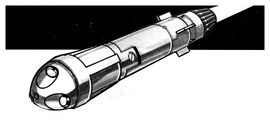
Missiles in Centurion[]
W.i.P.
Missile Stats[]
---
Missiles in Interceptor[]
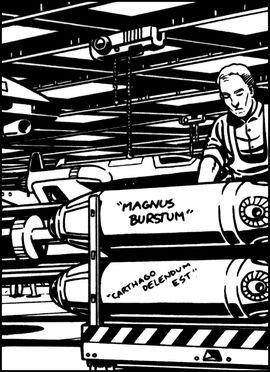
Missiles are disposable guided weapons frequently used on starfighters.
Missiles are one-shot, guided, self-propelled, disposable weapons carried by many starfighters and patrol craft. They are mounted on external fuselage hardpoints and can be reloaded or interchanged quickly between missions. Hardpoints can also be used to mount special equipment, such as painting lasers for ground attack missions, ECM pods to spoof enemy missiles, or sensor pods for reconnaissance flights.
All missiles consist of an explosive or laser warhead and a guidance system. Space, weight and displacement restraints dictate a trade-off between damage potential and guidance; the more sophisticated the target acquisition and following electronics, the less space there is for the warhead. Heavy ordnance missiles tend to have huge damage profiles but can be easily outmenoeuvered by an experienced pilot, while lighter missiles do less damage but will more readily keep a lock-on despite the target´s evasion manoeuvers and are much less susceptible to electronic countermeasures.
Missiles usually have a lock-on arc of 60° to the front of the fighter or turret they are mounted in.
---
Hardpoints[]

TOG Manubalista firing a missile from its bow hardpoint.
A hardpoint is a place on the turret or fuselage of a craft where missiles can be attached. It consists of a simple lock- and-release mechanism and an interface where the missile can exchange data with the ship´s computer for a lock-on. Since they are mounted externally, expended missiles can be replaced quickly on their hardpoints.
Armed missiles that failed to be released (due to a glitch in the software or a faulty clamp that refused to open) and missiles that have been damaged by enemy fire are a terrible hazard to ground crews. The same goes for crash landings that can set off the externally-mounted warheads. Fighter pilots are encouraged to get rid of all their missiles, preferrably in the direction of the enemy, before returning to base.
---
Autoloading Hardpoints[]
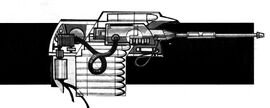
An autoloading hardpoint and its attached magazine.
Larger patrol vessels and installations often mount magazine-fed launchers. This enables the craft to carry a magazine of ten missiles that can be launched one per round. The magazine can hold missiles of different types, and the gunner can fire them in any sequence.
Once all missiles are expended, the magazine can be replenished at an installation or aboard a capital ship. It takes 20 Interceptor game turns to reload a magazine.
The issue with internal ammunition storage is that once the launcher is destroyed, the remaining missiles explode within the carrying ship, causing their full damage against the internal structure.
---
Radiation Intensity Seeking (RIS) Missile[]
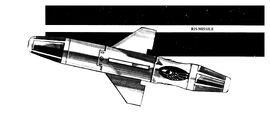
Radiation Intensity Seeking Missile, as shown in the Renegade Legions Fighter Briefing.
This missile homes in on the target plant´s radiation and must be locked on and fired at the target´s rear (where the main drive exhausts are located). RIS missiles are easy to shake off but carry a large explosive load that can seriously damage even heavy fighters. They are rarely used against starfighters, but are excellent weapons against ground targets or orbital installations, and are used to good effect by large fighter formations against capital vessels.
Launching Time[]
- Combat Phase
- Lock-On immediately after launching.
Starting Velocity and Heading[]
- Velocity as firing ship
- Heading as firing ship
- Facing as turret or firing ship
Lock-On Conditions[]
- Target within firer´s 60° front arc
- Firer within target´s 120° rear arc (unless fired at an installation)
- Range over 30 km (2 hexes) and under 150 km (10 hexes)
- Roll against Gunnery skill
If Lock-On Is Lost[]
- Scans all potential (friendly or enemy targets in forward 60° arc[1] and within 150 km (10 hexes), starting with closest target. Lock-on on 5-.
- If all lock-on rolls fail, missile is removed.
---
Scanner Silhouette Seeking (SSS) Missile[]

A Penetrator takes a hit from a SSS missile launched by a Spiculum.
SSS missiles memorize the shape of the target as determined by their initial scan. They do not rely on the target´s radiation emission and are hard to evade even by experienced pilots. As such, they are the weapon of choice in dogfights against other fighters. Their damage profile is somewhere between the RIS and TGM missiles.
Launching Time[]
- Combat Phase
- Lock-On before launching. If lock-on fails, missile is not launched.
Starting Velocity and Heading[]
- Velocity as firing ship
- Heading as firing ship
- Facing as turret or firing ship
Lock-On Conditions[]
- Scanner on firer functional
- Target within firer´s 60° front arc
- Range over 30 km (2 hexes) and under 450 km (30 hexes)
- Roll against Gunnery skill
If Lock-On Is Lost[]
- Missile is removed.
---
Transponder-Guided (TGM) Missile[]
These missiles are usually dropped to cover a retreat or to break up enemy fighters moving in formation. They do not rely on the pilot´s or gunner´s skill but choose their targets themselves, homing in on transponder signals broadcast by the ship´s IFF ("Identify Friend or Foe") beacon. The older Mark I variant of the missile is easily misled by faked transponder signals and may even attack a friendly vessel if it has a damaged transponder onboard. The Mark II variant also checks the target´s silhouette against a database of friendly ships to provide a measure of safety.
Faking a fighter´s own transponders to imitate an enemy signal is a tactic sometimes employed in solitary raids but almost never where other friendly forces operate; the danger of becoming a victim of friendly fire or drawing forces of one´s one side off from a vital objective far outweighs the ability to confuse the occasional TGM missile.
Launching Time[]
- Any time, even during movement.
- No manual lock-on is required. Missile chooses its own targets in the Combat Phase.
Starting Velocity and Heading[]
- Velocity 0
- Facing as turret or firing ship
Lock-On Conditions[]
- See: "If Lock-On Lost"
If Lock-On Is Lost[]
- During Combat Phase, missile makes a lock-on roll against ((any friendly vessel with damaged transponder) or (enemy vessel)) within 450 km (30 hexes), starting with closest target.
- If all rolls fail, missile stays in place, but is not removed.
- Mark I rolls 8 or less to lock on to a target.
- Mark II rolls against a number depending on the target transponder´s state (see table below)
| Transponder Condition | Lock-On Roll |
|---|---|
| Enemy transponder working | 7 or less |
| Enemy transponder disabled | 4 or less |
| Friendly transponder working | No chance |
| Friendly transponder disabled | 3 or less |
---
Dead-Fire Missile (DFM) Cluster[]
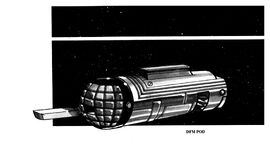
A DFM pod, as shown in the Renegade Legions Fighter Briefing.
The DFM cluster is basically a large one-shot shotgun mounted to a missile hardpoint. The weapon fires a cloud of small, high-velocity unguided missiles, the rationale being that if you shoot enough missiles at a target, some will get through the shields. It is a close-in weapon system with a range of less than 90 kilometers. Unlike other missiles, it is fired like a regular weapon system during the Combat Phase, and follows the same firing procedures.
Launching Time[]
- Combat Phase.
- Fired like a direct fire weapon system, but with a +4 to-hit modifyer.
---
Electronic Counter-Measures (ECM) Pod[]
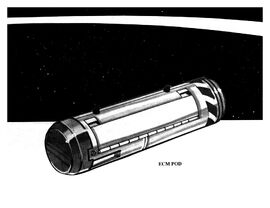
ECM pods are often mounted on hardpoints to spoof enemy missiles.
While much less effective than decoy ECM missiles (see below), ECM pods are reusable. They continuously broadcast jamming signals to try and break a missile´s final attack lock-on. ECM pods have no effect on the initial lock-on roll, but have a moderate chance of spoofing an incoming missile shortly before it impacts. Fighters may carry several pods, but only one can be active at any time.
---
Electronic Counter-Measures (ECM) Missile[]
This is an "anti-missile missile" carried on a hardpoint. Launched just as an enemy missile completes its attack run, it sends out strong jamming signals to confuse the attacing missile´s sensors, and acts as a decoy, projecting a power output similar to the target fighter. If successful, the enemy missile confuses the ECM missile with its target and will home in on it. ECM missiles are very effective against missiles, but they are strictly one-shot countermeasures. Once all are used up, the fighter is vulnerable to further missile attacks.
Lock-On Conditions[]
- No lock-on required; must be launched the moment a missile hits.
---
Sensor Pod[]
Fighters on reconnaissance missions often carry sensor pods on their hardpoints. The surveillance equipment inside the pod amplifies the craft´s long range scanning and passive data gathering ability.
---
Ground-Attack Pod[]
For ground-support and strafing missions, this pod provides the fighter with a painting laser able to read a tank´s shield flicker rate. An onboard computer analyses the frequency and times the firing of the fighter´s weapons to slip through during the "off" phase of the shields. This effectively negates the target´s shields completely. Friendly craft can profit from the painting as long as the painting fighter´s communications equipment is working.
Tanks constantly vary their shields´ flicker phases slightly to throw off the effect of painting. Fighters and patrol vessels don´t, and once painted stay painted. In space combat, though, the ranges are too long for the exact timing, and painting is ineffective.
Missile Stats[]
| Weapon | Damage / Effect | Thrust | Intelligence | Base To-Hit Number | Power | Mass (Tons) | Cost (Talents) |
|---|---|---|---|---|---|---|---|
| Missile Hardpoint | - | - | - | - | - | 3 | 10,000 |
| Autoloading Hardpoint | - | - | - | - | - | 100 | 300,000 |
| Weapon | Damage / Effect | Thrust | Intelligence | Base To-Hit Number | Power | Mass (Tons) | Cost (Talents) |
| Sensor Pod | Defined by scenario rules | - | - | - | - | - | - |
| Ground Attack Pod | Acts as painting laser on grav vehicles´ shields | - | - | - | - | - | - |
| ECM Pod | -3 to all missile to-hit rolls against fighter | - | - | - | - | - | - |
| ECM Missile | -8 to one missile´s to-hit roll against fighter | - | - | - | - | - | - |
| Weapon | Damage / Effect | Thrust | Intelligence | Base To-Hit Number | Power | Mass (Tons) | Cost (Talents) |
| RIS Missile |  |
12 | 5 | 12 | - | - | - |
| SSS Missile |  |
15 | 8 | 15 | - | - | - |
| TGM Missile |  |
?[2] | 7 | 15 | - | - | - |
| DFM Missile Cluster |  |
- | None | (+4) | - | - | - |
Annotations[]
- ↑ The Interceptor rulebook only says "within the missile´s front arc"; it does not state whether this is the usual 120° front arc or the 60° lock-on arc. Also, it is not stated whether a fighter must present its 120° rear arc to the missile to be a viable target for lock-on (which would be logical).
- ↑ No Thrust value is given for a TGM in the Interceptor rules. It may be assumed that the thrust of the missile is similar to that of the SSS missile (15 points).



